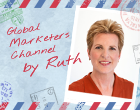マーケティングキャンパス 基礎から実践までB2Bマーケティングを学ぶサイト
ホーム > コラム > ルース教授のグローバル講座 ─Global Marketers Channel by Ruth─ > 休眠顧客を掘り起こすアプローチ─The Case for Customer Reactivation─
2018.10.22

休眠顧客を掘り起こすアプローチ
─The Case for Customer Reactivation─
グローバル担当者向け
マーケティングの進化に伴い、リテンションやリアクティベーションの重要性が注目されています。しかし一方で、休眠顧客を掘り起こすために最適な方法を理解しているマーケターは非常に少なく、多くの場合は貴重な機会を損失しています。
マーケティングの進化に伴い、多くのマーケターが、顧客中心のマーケティング活動を実現するために、リテンション(保持)およびリアクティベーション(復活)の重要性を理解するようになってきました。ここに明らかな事実があります。
ゼロから新規顧客を創出するよりも、休眠顧客を復活させるためのコストは遥かに少ない
直近のマーケティング活動は、カスタマーライフタイムバリュー(顧客生涯価値)を見る上での強力な指標である
リテンション・マーケティングへの投資が、あらゆる戦略の中で最も高いROIをもたらす
しかし、一部のマーケターは、今日のリアクティベーション・マーケティング(休眠顧客を掘り起こすアプローチ)における最良の方法を見逃しています。
休眠顧客との新たな関係を促進し、顧客離反や解約を減らすために最も効果的な戦略を見てみましょう。
リアクティベーション・マーケティングは、B2CからB2Bに至るまで、あらゆる製品およびサービスに適用でき、サブスクリプションモデルや替え刃モデルなどのビジネスモデルにおいては、戦略とツールも進化を遂げています。
これらを既に実行している事例から学びましょう。
顧客リアクティベーションへの投資の正当性を証明するために、有益な統計情報を紹介します。
“顧客離反を5%減らすことで、顧客別の利益を25%〜85%増加させることができる”
Reichheld, The Loyalty Effect“顧客との関係を更に2%維持することは、コストを10%削減することと同じ効果がある”
Davidow & Malone, The Virtual Corporation“新規見込み客を創出と比較し、既存見込み客に販売するコストは20%に抑えることができる”
Aberdeen Group research
リアクティベーション・マーケティングは、リテンション・マーケティングの一部と考えられます。顧客とのコミュニケーション回数が減るにつれて、それは顧客が離反する可能性が高くなります。したがって、早めにそのシグナルをキャッチして、離反防止のために、対策を講じることが重要です。
対策を講じる前に、次の重要な項目を定義する必要があります。
1. 自社のビジネスにおける休眠の定義
多くの場合、休眠の最終的な結果は“解約”だとされています。
解約率は、ある期間中に失った顧客数を、初期に獲得した顧客数で割ったものです。
しかし、顧客の購入経路はビジネスによって異なります。例えば、新車を購入することは、保湿クリームを補充することとは異なります。要するに、最もポイントとなる中間測定基準を特定する必要があります。自動車ディーラーの場合は、オイル交換をエンゲージメントの指標とするべきです。デパートの場合は、メール開封率やクリックスルーレートのような中間測定基準とあわせて、製品購入頻度とタイミングを指標として捉えるべきです。
2. 休眠顧客になった理由
顧客が自社サービスや製品について問題を感じている場合、その問題を解決するように努力する必要があります。また、顧客ニーズを満たしていない場合は、顧客に有益なサービスを提供する方法を考え出す必要があります。さらに、競合他社に乗り換えられた可能性がある場合は、顧客に戻ってきてもらうための策を講じる必要があります。このように、考えられる理由は様々です。メールや電話での簡単な調査は、これらの可能性を特定するのに有効でしょう。それぞれの可能性に対し、個別の戦略的アプローチが必要になるのです。
3. 休眠顧客をリアクティベーションする(掘り起こす)価値
一部の休眠顧客は、単に収益に繋がりません。その場合は、再エンゲージメントに投資するよりも、諦めることが良い戦略かもしれません。もしリアクティベーションに投資する価値が少しでもある場合、予測される顧客価値を評価することで、最適なリアクティベーションの投資額を決めやすくなるでしょう。
4. どのように成功を測定するか
多くの企業は、顧客の再購入を測定しています。有益な測定基準は、復活した顧客数を、初期の休眠顧客数で割った復活率です。ビジネスにおいて、成功の基準は様々です。重要なのは、予め最も有効な測定基準を設定し、実施するリアクティベーションプログラムの結果を分析することです。
ルース・スティーブンス プロフィール
アメリカのBtoBマーケティングを代表するコンサルタント
コロンビア大学客員教授。イーマーケティングストラテジー社 代表取締役。
コロンビア大学経営大学院卒業、MBA取得。タイム・ワーナー社、ジフ・デイビス社、IBM社などでマーケティングの要職を歴任。米国のBtoBマガジンで最も影響力のある100人のひとり、またリードマネジメント協会の注目すべき女性20人にも選ばれている。数多くのメディアにもブロガーとして寄稿し、B2Bマーケティングをテーマにした多くの著書がある。
As marketing advances, most marketers are well aware by now of the importance of retention and reactivation in optimizing the value of the customer base. However, some marketers may still be missing out of some of today’s best practices in reactivation marketing and in many cases end up with losing treasured opportunities.
As marketing advances, most professionals are well aware by now of the importance of retention and reactivation in optimizing the value of the customer base. The facts are clear: We know that it costs far less to reactivate a dormant customer than to acquire an entirely new one; we know that recent activity is a powerful indicator of customer lifetime value; and we know that investments in retention marketing deliver the highest ROI of any strategy.
But some marketers may still be missing out of some of today’s best practices in reactivation marketing. Let’s review the strategies that are most effective in stimulating a renewed relationship with your dormant customers, and reducing customer defection and churn.
Reactivation marketing applies to all kind of product and services categories, from consumer to business markets. The tactics and tools have been developed and refined to a fine art in the area of subscriptions and replenishment types of marketing. Let us learn from these trailblazers.
If you need backup to justify your investment in customer reactivation, here are some useful stats:
A 5-point decrease in defections can lift per-customer profit by 25% to 85% (Reichheld, The Loyalty Effect)
Retaining an additional 2% of customers has the same effect as cutting costs 10% (Davidow & Malone, The Virtual Corporation)
It is 4.8 times cheaper to sell to a pre-existing inquirer than to generate a new lead (Aberdeen Group research)
Reactivation can be viewed as a subset of retention marketing. If a customer has stopped interacting with you, this is very likely an early indicator of upcoming customer loss, or defection. So, it’s essential to identify the signals early, and set up intervention activity to prevent the customer from moving further away.
Before you can plan your best intervention tactics, you need to develop answers to several key questions:
1. How should you determine the definition of inactivity in your business?
For many, the end result of inactivity is known as “churn.” The churn rate is derived from dividing the number of customers lost in the period by the number of customers you had at the beginning of the period. But the path to purchase differs with each business. Buying a new car is very different from replenishing your supply of moisturizer. This means identifying the interim metrics that you need to keep an eye on. A car dealer may look at oil changes as an indicator of engagement. A department store will look at the such indicators as product purchase frequency and timing, with interim metrics like email open and click through rates.
2. What are the reasons for customer dormancy?
It may be that your customers had a problem with your product or service. In which case, you must strive to fix the problem. It may be that they no longer have a need. In which case, you need to determine whether there’s another way to serve them profitably. Or it may be that they have left for a competitor. In which case, you must institute a winback effort. There are many possible reasons. A quick survey by email or phone will help you identify them Each will likely require a different strategic approach.
3. Is the customer worth reactivating?
Some customers simply cannot be served profitably. For them, it may be a better strategy to let go, instead of investing more in re-engagement. Thus, an assessment of projected customer value will help you determine the appropriate amount of reactivation investment, if any.
4. How will you know success when you see it?
For many companies, reactivation is measured by conversion to repurchase. A useful metric is the winback rate, calculated as the number of reactivated customers divided by the number of inactives at the beginning of the period. For your business, the success metric may be something different. The point is to identify the most appropriate metric in advance, and track the results of your reactivation program over time.
Ruth P. Stevens Bio
Ruth P. Stevens consults on customer acquisition and retention, teaches marketing at business schools in the U.S. and abroad, and is a guest blogger at Biznology and Target Marketing Magazine, and a contributing writer at AdAge. Crain’s BtoB magazine named Ruth one of the 100 Most Influential People in Business Marketing. Her newest book is B2B Data-Driven Marketing: Sources, Uses, Results. Ruth has held senior marketing positions at Time Warner, Ziff-Davis, and IBM and holds an MBA from Columbia University. Learn more at www.ruthstevens.com.